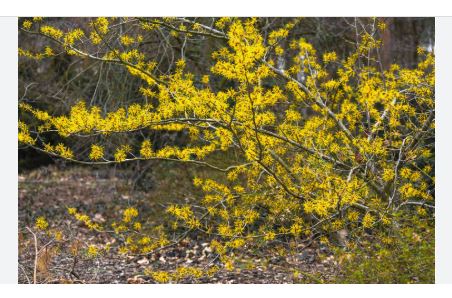
Common Witch Hazel (Hamamelis virginiana) is classified under the family Hamamelidaceae. It’s a member of the Hamamelis genus, which includes several species known for their unique flowering times.
This species is native to North America, specifically found from Nova Scotia in Canada, southward through the eastern United States to Florida, and westward to Texas. It thrives in a variety of habitats including woodlands, stream banks, and forest edges.
Witch Hazel has a rich history with Native American tribes using it for medicinal purposes, particularly for treating skin conditions, wounds, and inflammations. The name “witch hazel” comes from the Old English “wiche,” meaning pliable or bendable, referring to the use of its branches for divining rods. Its astringent properties have been commercially exploited since the 19th century, leading to the production of witch hazel extracts and toners.
Common Witch Hazel is a deciduous shrub or small tree, growing typically to 15 to 30 feet tall. It’s notable for its late fall to early winter blooming, with spidery, yellow flowers that appear when the leaves have mostly fallen, providing a striking contrast against the bare branches or even snow. The leaves are broadly oval with wavy margins, turning yellow in autumn. The plant also produces small, woody capsules that explosively release seeds when ripe.
This species is hardy in USDA Zones 3 through 8, showcasing its ability to tolerate a wide range of temperatures, from cold northern winters to warm southern climates.
With proper conditions, Common Witch Hazel can live for many decades, often over 50 years, making it a long-term investment in landscape design. Its slow growth and hardiness contribute to its longevity.
Landscape Uses
Common Witch Hazel has multiple applications in landscaping:
- Ornamental Value: Its unique blooming time and the beauty of its flowers make it a standout in autumn and winter gardens. The plant is also valuable for its fall foliage.
- Privacy Screening: It can be used as a hedge or for screening due to its dense growth habit, providing both privacy and a habitat for wildlife.
- Naturalizing: It’s ideal for naturalistic landscapes where its ability to blend into woodland settings is appreciated.
- Erosion Control: Its extensive root system helps stabilize soil on slopes, making it beneficial for erosion-prone areas.
- Pollinator and Wildlife Support: Although less known for attracting pollinators due to its late bloom, it still provides some nectar for late-flying insects, and its seeds and cover are valuable for birds and small mammals.
- Medicinal Garden: Given its historical use, it can be part of a medicinal or herb garden, where its astringent properties can be highlighted.
- Urban Gardening: Its tolerance for various soil types and conditions, including urban environments, makes it suitable for city gardens where space for native plants is limited.
Common Witch Hazel (Hamamelis virginiana): Cultivation
Selecting the Right Location
Common Witch Hazel thrives in full sun to partial shade, preferring morning sun with afternoon shade in hot climates. The ideal spot should offer well-drained soil but can handle various soil types from sandy to loamy, provided they’re not waterlogged.
Soil Requirements
This plant adapts to a range of soil pH levels but grows best in slightly acidic to neutral soils. Good drainage is key to prevent root rot, so if your soil is heavy clay, consider amending it with organic matter or choosing a raised bed.
Planting
Plant Common Witch Hazel in either early spring or fall. Dig a hole that’s twice as wide as the root ball but no deeper. Place the plant, ensuring the root collar is level with the ground, backfill with soil, and water thoroughly to settle the soil around the roots.
Watering
Initially, water regularly until the plant is established, which might take a couple of years. Once mature, it’s quite drought-tolerant, but deep watering during extended dry periods will promote health and flowering. Avoid overwatering, especially in winter, to prevent root issues.
Mulching
Apply a 2-3 inch layer of mulch around the base to help retain soil moisture, regulate soil temperature, and suppress weeds. Keep mulch away from the trunk to avoid moisture accumulation that can lead to decay.
Pruning
Pruning is generally minimal but can be done for shaping or to remove dead or diseased wood. The best time to prune is right after flowering in late winter or early spring, before new growth begins. Avoid heavy pruning, as it flowers on old wood.
Fertilization
Witch Hazel usually doesn’t require much fertilization if planted in fertile soil. If needed, apply a balanced, slow-release fertilizer in early spring. Over-fertilizing can lead to excessive leaf growth at the expense of flowers.
Pest and Disease Management
Common Witch Hazel is relatively pest-resistant, but watch for aphids, scale, or occasional leaf spots. Good air circulation helps prevent fungal issues. If pests are noticed, they can usually be controlled with insecticidal soap or by encouraging natural predators.
Propagation
Propagation can be achieved through seeds, which require cold stratification for germination, or via cuttings. Softwood cuttings in late spring or early summer tend to root best. Seedlings will take longer to mature and bloom compared to cuttings.
Managing Growth
Common Witch Hazel grows slowly, but it can spread via suckers. If you need to control its spread, remove suckers as they appear. This is less of an issue compared to some other sumacs but still worth monitoring.
Winter Care
In its hardiness zones, it’s very cold-resistant, needing no special winter protection. However, in colder regions or for young plants, a mulch layer can protect roots from frost heave.
Landscape Integration
Consider its late blooming when integrating into your landscape. It’s perfect for areas where you want seasonal interest in fall and winter. Pairing with early spring bloomers can extend the garden’s interest period.